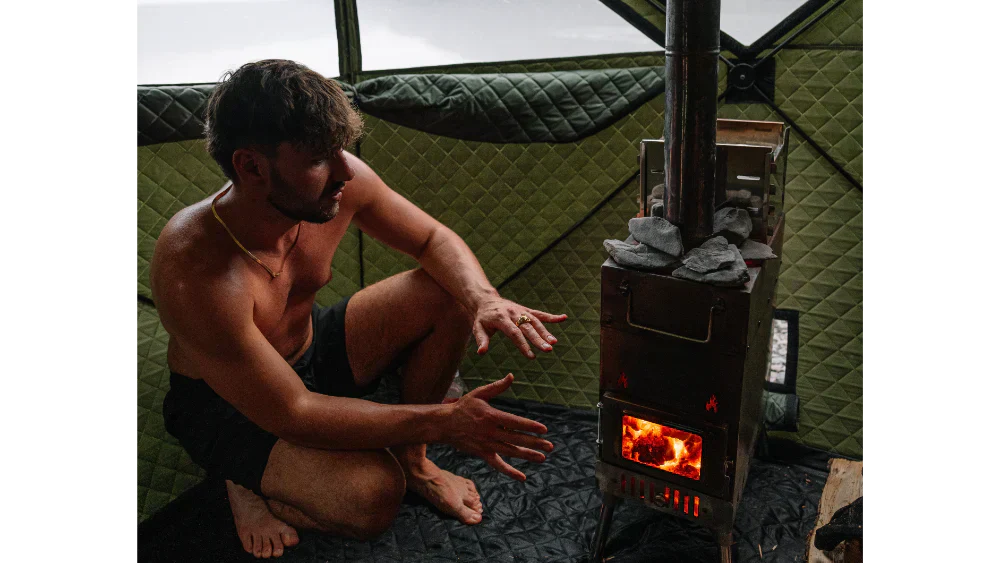For centuries, sauna bathing has been an essential part of life in Nordic countries. From traditional Finnish saunas to modern steam sauna setups, the core ritual has always remained the same: enter a small room, raise your body temperature, and let the heat do its work. But what does the sauna do exactly? And how do different types of saunas, like infrared saunas, steam rooms, dry saunas, or the Russian banya, impact your health?
At Kyfe, we believe that understanding the science behind sauna use enhances the experience. Whether you're using a private sauna in your backyard or visiting recreational facilities, the potential health benefits of regular sauna sessions are both powerful and well-documented. Let’s explore what happens to your body in a sauna, and why traditional saunas continue to deliver unmatched wellness results.
The Purpose of Sauna Bathing

Sauna bathing is far more than sitting in a hot space. It is a form of heat stress that activates key systems within the body. When exposed to high temperature and low humidity, or wet heat in the case of a steam sauna, the body reacts as if it were exercising. Your pulse rate increases, blood vessels expand, and sweat glands activate. These physiological responses contribute to many health effects, including improved cardiovascular health, healthy blood pressure regulation, reduced stress, and relief from chronic pain.
This ritual has been passed down for generations. Traditional Finnish saunas use heated rocks and wood fire to produce both dry heat and steam, depending on how much water is poured onto the stones. The resulting environment is immersive, with relative humidity fluctuating between 10 and 20 percent, unless additional water is added for a steam burst.
What Happens Inside the Body?
Increased Blood Circulation and Heart Health
The moment you enter a sauna, your cardiovascular system begins to adjust. Heart rate may climb to 120–150 beats per minute, mimicking the effects of moderate physical activity. This process is often referred to as passive cardio. The result is increased blood circulation and the temporary lowering of blood pressure in healthy individuals, supporting healthy blood pressure maintenance.
According to data cited in Mayo Clinic Proceedings, regular sauna use has been associated with reduced risk of cardiovascular disease, including heart attack, high blood pressure, and even sudden cardiac death. Notably, Finnish men who engaged in regular sauna bathing experienced a lower incidence of heart disease, stroke, and Alzheimer's disease.
Kyfe Sauna, which operates using traditional wood fire and heated rocks, provides the same cardiovascular stimulation seen in long-established Finnish saunas. The high temperature environment combined with wet heat enhances circulation and aids vascular flexibility.
Detoxification Through Sweat
One of the most obvious sauna benefits is sweating, but what does this process actually do? Elevated body temperature prompts the sweat glands to release fluids through the skin. This helps eliminate trace heavy metals, environmental toxins, and metabolic waste. While research continues to explore the exact detoxifying mechanisms, many users report improved skin clarity and a sense of physical renewal after a single session.
Steam sauna environments promote deeper sweating due to the combined effects of heat and humidity. When water is poured over heated rocks inside a Kyfe Sauna, steam envelopes the small room and accelerates perspiration. This wet heat can feel more intense than dry heat but is generally well-tolerated by those accustomed to sauna therapy.
Stress Reduction and Nervous System Regulation
Modern life overstimulates the nervous system. Sauna use helps reset it. As your pulse rate increases and your muscles relax, cortisol levels begin to drop. This hormonal shift creates a calming effect, which is why so many sauna users report feeling mentally clear and emotionally grounded after a session.
For those experiencing anxiety or insomnia, sauna therapy can be a powerful tool. It creates the physical heat stress necessary to activate recovery pathways, allowing the body and mind to shift from sympathetic (fight-or-flight) to parasympathetic (rest-and-digest) mode. Many health effects stem from this transition, including improved sleep and better mood regulation.
Types of Saunas and How They Differ
Traditional Finnish Saunas
These wood-fired saunas use a central furnace to heat stones, which then radiate dry heat. Water can be added for steam, increasing relative humidity. They typically reach temperatures over 180°F, creating a deeply penetrating heat. Kyfe Sauna falls into this category, combining high heat with real steam for an authentic experience.
Infrared Sauna
Infrared saunas use infrared light to heat the body directly rather than warming the surrounding air. They usually operate at a lower temperature, between 120°F and 150°F, and produce radiant heat that penetrates the skin. While some users tolerate sauna conditions better at these lower levels, the overall cardiovascular activation and sweating tend to be less intense than in traditional saunas.
Steam Room
Steam rooms are fully enclosed, tile-lined spaces that operate at lower temperature but extremely high humidity, often near 100 percent. While the environment is moist and soothing, it lacks the dry heat intensity of a Finnish-style sauna. Steam rooms are common in spas and recreational facilities but do not offer the same heart rate elevation as dry saunas or wood-fired models.
Dry Sauna
This type of sauna typically uses electric heating to warm the air. It provides dry heat without humidity unless water is added manually. Dry saunas are easy to maintain and are found in gyms and home wellness setups. However, many users find them less invigorating than wood-fired or steam-enhanced options.
Russian Banya
The Russian banya is a traditional sauna variant characterized by high heat and steam, often combined with the use of venik (birch or oak leaf bundles) for massage and circulation stimulation. It emphasizes alternating heat exposure with cold water plunges, which enhances vascular health and recovery.
The Health Benefits of Regular Sauna Use

Sauna use has been linked to many health benefits through both anecdotal and clinical evidence. A systematic review of existing studies confirms that regular sauna sessions can support:
-
Cardiovascular health
-
Healthy blood pressure regulation
-
Reduced blood pressure in people with hypertension
-
Improved pain in people with rheumatoid arthritis and chronic pain conditions
-
Lower inflammation markers
-
Relief from sore muscles and exercise recovery
-
Enhanced sleep quality and reduced stress
-
Improved skin clarity and tone
-
Possible weight loss through increased calorie expenditure
-
Reduced risk of Alzheimer's disease
It’s worth noting that while saunas are generally safe for most people, they may not be appropriate for individuals with certain health conditions. People with low blood pressure, heart disease, or other medical conditions should consult a physician before beginning regular sauna use. It's also important to tolerate sauna environments gradually, especially in high temperature settings.
What Makes Kyfe Sauna Different?
Kyfe Sauna is a portable, wood-burning modern sauna designed for those who want the full experience of traditional Finnish saunas in outdoor settings. Unlike an infrared sauna or electric unit, Kyfe uses real fire, real rocks, and real steam. It delivers dry heat and wet heat in one integrated system, reaching temperatures over 200°F.
Each Kyfe unit is full-sized, meaning you can sit, lie down, or stretch comfortably. It fits four to six people, making it ideal for community use or private saunas in your backyard or cabin. The materials are durable, weather-resistant, and designed for outdoor use all year round.
With Kyfe, you don’t just use a sauna, you create a ritual. Whether you set it up after a cold water plunge in the lake or as part of a winter recovery practice, the experience is immersive and grounding.
How to Use a Sauna Safely

When starting sauna therapy, begin with short sauna sessions lasting 10 to 15 minutes. Gradually build up tolerance and pay attention to hydration. Take breaks between sessions, and always follow with a cool shower or cold water plunge to close your pores and stabilize your body temperature.
Avoid using a sauna if you’re under the influence of alcohol or medication that impairs thermoregulation. If you have pre-existing medical conditions like high blood pressure, consult with your doctor. Sauna use is generally safe for most healthy individuals but should always be practiced with awareness.
Key Safety Tips:
-
Keep sessions to 15–20 minutes
-
Hydrate before and after
-
Avoid eating heavy meals before sauna use
-
Use gloves when handling wood fire components
-
Leave the space immediately if you feel dizzy or unwell
Sauna Benefits for Recovery and Resilience
More than just relaxation, sauna use builds physical resilience. It conditions your cardiovascular system, flushes toxins, and lowers mental stress. When used regularly, it can become part of a long-term wellness strategy alongside nutrition, movement, and sleep hygiene.
For those managing chronic pain, sauna sessions offer gentle physical therapy. The combination of heat and humidity can improve pain thresholds, reduce stiffness, and support mobility.
Likewise, those seeking to reduce stress and improve sleep quality will find the sauna to be a simple but profound tool. After just one session, many report deeper sleep and a more regulated nervous system.
Final Thoughts: What Does the Sauna Do Exactly?
The answer is both simple and powerful. Saunas raise your body temperature, stimulate circulation, and prompt your body to sweat. But beyond the science, they offer a rare invitation to slow down. Whether you’re in a steam sauna, dry sauna, or traditional wood-burning setup, the effects ripple out far beyond the heat.
Kyfe Sauna delivers all the core benefits of traditional Finnish saunas in a modern, portable format. It honors the old ways while embracing the freedom to set up wherever life leads. If you’re seeking a proven, natural way to reduce stress, improve sleep, support heart health, maintain healthy blood pressure, and reconnect with yourself, this is the ritual you’ve been waiting for.



Sauna While Fasting: How Combining Heat and Hunger Enhances Your Health Routine
What Is the 200 Rule for Saunas? A Complete Guide to Safer, Smarter Heat